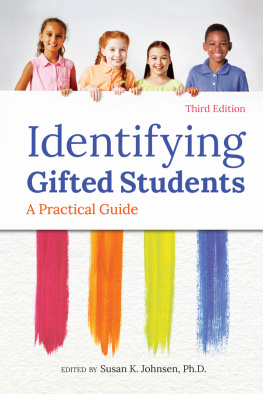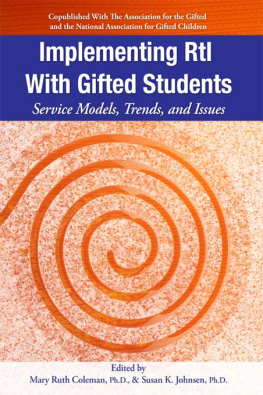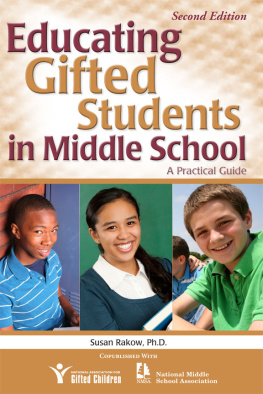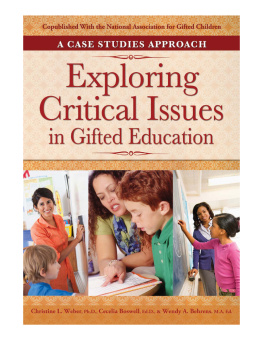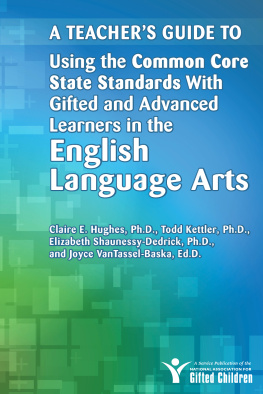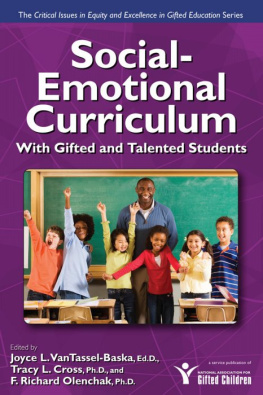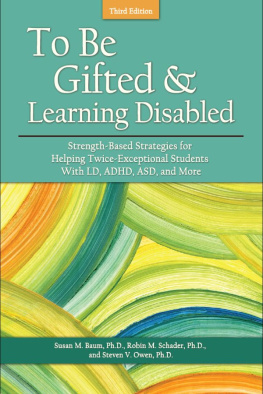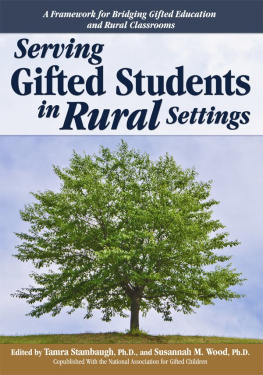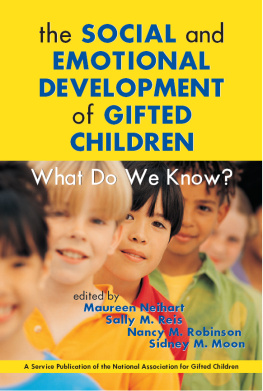


Library of Congress Cataloging-in-Publication Data
Names: Johnsen, Susan K., editor.
Title: Identifying gifted students : a practical guide / edited by Susan K. Johnsen, Ph.D.
Description: Third edition. | Waco, Texas : Prufrock Press Inc., [2018] | Includes bibliographical references.
Identifiers: LCCN 2018031177 (print) | LCCN 2018033658 (ebook) | ISBN 9781618215888 (eBook) | ISBN 9781618215895 (ePub) | ISBN 9781618215871 (paperback)
Subjects: LCSH: Gifted children--Identification.
Classification: LCC HQ773.5 (ebook) | LCC HQ773.5 .J64 2018 (print) | DDC 305.9/089083--dc23
LC record available at https://lccn.loc.gov/2018031177
Copyright 2018, Prufrock Press Inc.
Edited by Katy McDowall
Cover and layout design by Allegra Denbo
ISBN-13: 978-1-61821-589-5
No part of this book may be reproduced, translated, stored in a retrieval system, or transmitted, in any form or by any means, electronic, mechanical, photocopying, microfilming, recording, or otherwise, without written permission from the publisher.
For more information about our copyright policy or to request reprint permissions, visit https://www.prufrock.com/permissions.aspx.
At the time of this books publication, all facts and figures cited are the most current available. All telephone numbers, addresses, and website URLs are accurate and active. All publications, organizations, websites, and other resources exist as described in the book, and all have been verified. The authors and Prufrock Press Inc. make no warranty or guarantee concerning the information and materials given out by organizations or content found at websites, and we are not responsible for any changes that occur after this books publication. If you find an error, please contact Prufrock Press Inc.

| Prufrock Press Inc.
P.O. Box 8813
Waco, TX 76714-8813
Phone: (800) 998-2208
Fax: (800) 240-0333
http://www.prufrock.com |
Table of Contents
Preface
Overview of Assessment
Susan K. Johnsen
Assessment is the process of gathering information by using appropriate tests, instruments, and techniques. The information is gathered for a specific purpose, such as screening, classification or selection, curriculum planning or diagnosis, program planning, and progress evaluation.
Similar to the other editions, the third edition of Identifying Gifted Students: A Practical Guide focuses on screening and selecting gifted and talented students. It is designed for practicing professionalsteachers, counselors, psychologists, and administratorswho must make decisions daily about identifying and serving gifted and talented students. All of the information included in the chapters has been updated using standards and current research in the field.
It is aligned with the National Association for Gifted Children (NAGC) Pre-KGrade 12 Gifted Programming Standards (NAGC, 2010) and the The Association for the Gifted, Council for Exceptional Children (CEC-TAG) and NAGC professional development standards (2013; see for Standard 4: Assessment from the NAGC/CEG-TAG Teacher Preparation Standards). Both of these sets of standards emphasize the following important characteristics in developing a comprehensive identification system:
Procedures are based on current theories, models, and research (NAGC/CEC-TAG 1.K2, 8.K2; NAGC 2.2.2).
All students with gifts and talents have equal access (NAGC/CEC-TAG 8.K1; NAGC 2.1, 2.3.1, 2.3.2).
Multiple assessments allow the expression of diverse characteristics associated with giftedness (NAGC/CEC-TAG 8.K1, 8.K2; NAGC, 2.1.1, 2.2.4).
Assessments are qualitative and quantitative, from a variety of sources, off-level as needed, nonbiased, equitable, dynamic, and technically adequate for their described purposes (NAGC/CEC-TAG 8.S1, 8.S2; NAGC 2.2.3, 2.3.1).
Professionals are adequately prepared to interpret assessments (NAGC/CEC-TAG 8.K2, 8.S1, 10.S5; NAGC 2.2.5).
Schools inform parents and guardians in their native language about the assessment process and collaborate with parents and other professionals (NAGC 2.1.2, 2.2.6, 2.3.3).
The assessment procedures are cohesive and ongoing (NAGC/CEC-TAG 8.K1; NAGC 2.2.1).
Comprehensive provisions include informed consent, committee review, student retention, student reassessment, student exiting, and appeals (NAGC/CEC-TAG 8.K1; NAGC 2.2.1)
This book has incorporated these important characteristics and is relevant in any state or setting that intends to meet these national standards and uses multiple assessments to identify gifted students within an increasingly diverse population.
In organizing the book, the following sequential set of steps in the identification process was considered:
Step 1: Identify the characteristics of gifted and talented students and program options.
Step 2: Select multiple assessments that match these characteristics and programs.
Step 3: Develop an identification procedure that ensures equal access for all students, including those from underrepresented groups, such as gifted students from poverty, from different ethnic groups, and with disabilities.
Step 4: Provide professional development for administrators and teachers.
Step 5: Provide an orientation for parents and interested community members.
Step 6: Administer assessments in a technically sound and responsible manner.
Step 7: Interpret results and place gifted and talented students in the best program options for them.
Step 8: Evaluate and revise assessment procedures.
In , Susan K. Johnsen reviews the definitions, models, and characteristics of gifted and talented students (i.e., Step 1 in the identification process). The definition used in this book is the federal definition, which emphasizes high achievement capability in multiple areas. This variation in students with gifts and talents is reflected in 32 states definitions (National Association for Gifted Children & the Council of State Directors of Programs for the Gifted [CSDPG], 2015).
Given the focus on capability or potential in the national definition, Franoys Gagns and Abraham Tannenbaums developmental models were identified as foundational to the federal definition because both emphasized the importance of factors that contribute to the development of gifts into talents. Given these models, identification becomes even more important in ensuring that each student is impacted by positive environmental and intrapersonal catalysts and learns how to become aware of and use chance factors as they appear throughout his or her life. These models are followed by lists of characteristics for each defined area that have been gleaned from assessment instruments, introductory texts, and research in gifted education. The chapter concludes by focusing on characteristics of hard-to-find gifted and talented students, which should encourage practitioners to cast a wide net in the identification process.
In , Gail R. Ryser explains approaches to qualitative and quantitative assessments, defining their differences and providing types of each assessment. Two of the most widely used qualitative assessmentsperformance-based and observationsare discussed in greater depth with specific examples. Regarding quantitative assessments, she defines norm- and criterion-referenced measures along with rating scales, achievement tests, and aptitude and intelligence tests. She then reviews reliability and validity issues, emphasizing that technical qualities must be addressed when using either qualitative or quantitative assessments.
Next page
